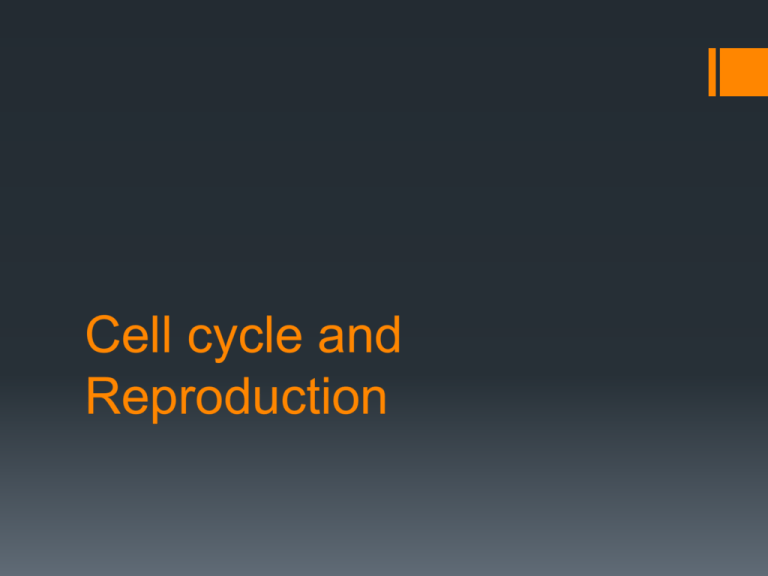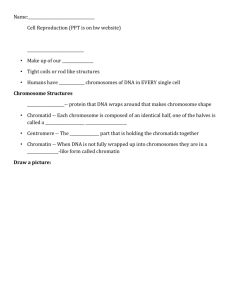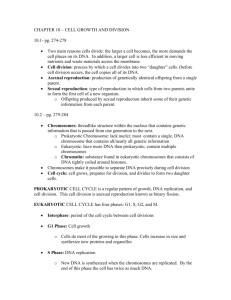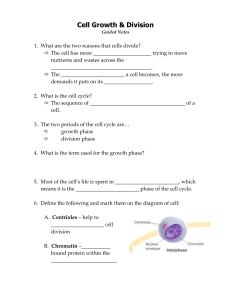Cell cycle and Reproduction - River Dell Regional School District
advertisement

Cell cycle and Reproduction BIO… LIFE…. THINK ABOUT THIS: What do we do in our lifetime? What are the major stages of our life? What are the Major stages of physical development in our lives? What would it look like if we put this into a pie chart? Imagine you are a bacteria: What are the major stages in your life? TRY ME: What is A? B? C? What is D/E/F/G collectively called? What is D? What is E? What is F? What is G? The life of a cell Cells have a life cycle just like we do- born, grow, reproduce, and die. They only spend part of their life cycle reproducing (M)- mitosis Cell Cycle 1. Interphase (G1, S, G2) – cell grows, prepares to divide (G phases) and DNA replicates (S phase) 2. Mitosis: nucleus divides; each nuclei winds up with the same # and kind of chromosomes as the parent (P-M-A-T) 3. Cytokinesis: division of cytoplasm COMING UP IN THIS CLASS… In the upcoming months, we will be analyzing what happens stages in great detail. Which stage do you think the following upcoming material will focus on? Topics to cover: - DNA structure and replication? - DNA structure and making Proteins (growth and homeostasis)? - Cell reproduction (asexual- bacteria)? - Cell reproduction (growth- multicellular)? Cell cycle: repeating sequence of cellular growth and division during the life of an organism; check points trigger the next stage of the cycle https://www.youtube.com/watch?v=65SO DTL_QsA WHY? THINK: Why do we have cycles and cells split? Why doesn’t the cell just get bigger and bigger? LIMITS TO CELL GROWTH AND LIFE CYCLE- PART 1 - NOTES- Handout AND PPT So what happens when cells get TOO LARGE???? THEY SPLIT- MITOSIS. BUT BEFORE WE TALK ABOUT WHAT CELLS DO EXACTLY IN MITOSIS, LET’S THINK ABOUT WHY CELLS DON’T JUST SPLIT ALL THE TIME???? Or in other words…. What happens if things go wrong with checkpoints? THINK ABOUT THIS!!!! Loss of Control of the Cell Cycle If checkpoints are not working properly, the cell cycle can cause the cell to grow uncontrollably leads to cancer . THINKING QUESTION: What biomolecule controls checkpoints? AMEOBA SISTERS: https://www.youtube.com/watch?v=lpAa4TWjHQ4&list=PLwL0Myd7Dk1F1ppDaLx3ygO_7xA-yyd4&index=2 PROTEINS AND CELL CYCLE REGULATION: 10.3 CYCLINS, GROWTH FACTORS, APOPTOSIS AN D CANCER.- Section 10.3- And what controls the making of proteins? DNA SO WHAT’S THE DIFFERENCE BETWEEN PROKARYOTIC AND EUKARYOTIC DNA How Is the DNA in Eukaryotic Chromosomes Organized? Eukaryotic chromosomes differ from prokaryotic chromosomes in important ways Eukaryotic chromosomes are separated from the cytoplasm by a membrane-bound nucleus Eukaryotic cells always have multiple chromosomes Eukaryotic chromosomes are longer and have more DNA than prokaryotic chromosomes (human chromosomes are 10 to 80 times longer and have 10 to 50 times more DNA) These differences account for the complexity of eukaryotic cell division How Is the DNA in Eukaryotic Chromosomes Organized? The eukaryotic chromosome consists of a linear DNA double helix bound to proteins Each human chromosome contains a single DNA double helix, about 50 million to 250 million nucleotides long Most of the time, the DNA in each chromosome is wound around proteins called histones These DNA-histone spools are further folded into coils Another layer of folding occurs as the coiled strand folds into loops, which are then attached to protein scaffolding, so that the chromosome is 1,000 times shorter than the extended DNA molecule During cell division, more proteins fold up the DNA and histones, until it is 10 times shorter than during its resting state Figure 9-4 Chromosome structure DNA double helix histone proteins DNA wound around histone proteins Coiled DNA/histone beads Loops attached to a protein scaffold; this stage of partial condensation typically occurs in a nondividing cell protein scaffold Folded chromosome, fully condensed in a dividing cell DIFFERENCES Cont… WHAT DO THE AMEOBA SISTERS HAVE TO SAY ABOUT THIS??? https://www.youtube.com/watch?v=ruBAHiij4EA HOW ARE THESE TERMS RELATED? FIRST…Find out what they mean. WE WILL REVIEW… THEN…Make a concept map. DNA HISTONES GENES SISTER CHROMATIDS CENTROMERE CHROMOSOMES LOCI TELOMERE- GENES, CHROMOSOMES, and DNA The DNA in a chromosome consists of two long strands of nucleotides wound around each other, as a ladder would look if it was twisted into a corkscrew shape This structure is called a double helix The units of inheritance, called genes, are segments of DNA The specific sequence of nucleotides in genes spells out the instructions for making the proteins of a cell When a cell divides, it replicates its DNA to make two identical copies, and gives each daughter cell one of the two copies 9.3 How Is the DNA in Eukaryotic Chromosomes Organized? Genes are segments of the DNA of a chromosome Genes are sequences of DNA from hundreds to thousands of nucleotides long Each gene occupies a specific place, or locus (plural, loci) on the chromosome 9.3 How Is the DNA in Eukaryotic Chromosomes Organized? In addition to genes, every chromosome has specialized regions that are crucial to its structure and function Two telomeres One centromere The two ends of a chromosome consist of repeated nucleotide sequences called telomeres, which are essential for chromosome stability 9.3 How Is the DNA in Eukaryotic Chromosomes Organized? Genes are segments of the DNA of a chromosome (continued) The second specialized region of the chromosome is the centromere, which has two principal functions 1. It temporarily holds two daughter DNA double helices together after DNA replication 2. It is the attachment site for microtubules that move the chromosomes during cell division Eukaryotes Chromosomes carry the DNA…but you need two IDENTICAL COPIES of DNA to go to the 2 cells chromosome # varies between species humans46 chromosomes (23 pairs) REMEMBER: The life of a cell Before cells can divide, DNA needs to be replicated So the code can be passed on. Which phase does this happen in???? DNA Replication Process of copying a double stranded DNA to form 2 double stranded molecules Basis of biological inheritance used by all living things Occurs before a cell divides (mitosis) DNA Replication 1. Enzymes break the hydrogen bonds between the bases so the chains of DNA can separate or unwind DNA Replication 2. Other enzymes add new nucleotides, which form new hydrogen bonds with their complimentary nucleotide. Red = original strand Blue = new strand DNA Replication Results in 2 semi-conservative double stranded molecules WHAT IS THE ROLE OF: HelicaseSSBReplication fork- DNA Polymerase- ANIMATIONS OF DNA REPLICATION http://www.bioteach.ubc.ca/TeachingResources/MolecularBiology/DNAReplication.s wf http://www.mcb.harvard.edu/Losick/images/TromboneFINALd.swf http://highered.mcgrawhill.com/sites/0072556781/student_view0/chapter11/animation_quiz_2.html http://www.sinauer.com/cooper/4e/animations0601.html AMEOBA SISTERS: https://www.youtube.com/watch?v=5qSrmeiWsuc&index=1&list=PLwL0Myd7Dk1F1p p-DaLx3ygO_7xA-yyd4 NOW ONCE THE DNA IS REPLICATED, THE CELL CAN DIVIDE! Asexual Reproduction (Mitosis) Asexual Reproduction Purpose of cell division: in simpler organisms: reproduction of offspring in complex organisms: increase number and size of cells; repair damaged cells only 1 parent is required parent DNA is passed onto offspring, therefore, offspring are IDENTICAL to parent MITOSIS: PHASES WHAT ARE THE PHASES OF MITOSIS WHAT HAPPENS IN EACH PHASE??? DNA replicates in interphase? Which part of cell cycle??? What happens in each: PROPHASE METAPHASE ANAPHASE TELOPHASE http://highered.mcgraw-hill.com/sites/0072437316/student_view0/chapter11/animations.html# no cell wall cell wall Mitosis parent cell 46 chromosomes 92 chromosomes 46 chromosom es daughter cells 46 chromosom es AMEOBA SISTERS: https://www.youtube.com/watch?v=gwcwSZIf KlM&list=PLwL0Myd7Dk1F1ppDaLx3ygO_7xA-yyd4&index=3 Figure 9-8 The eukaryotic cell cycle G1: cell growth and differentiation G2: cell growth and preparation for cell division S: synthesis of DNA; duplication of chromosomes CATEGORIES OF CELLS? Most multicellular organisms have three categories of cells 1.Stem cells 2.Other cells capable of dividing 3.Permanently differentiated cells STEM CELLS SO WHAT’S SO SPECIAL ABOUT STEM CELLS ANYWAYS??? Stem cells have two important characteristics: selfrenewal, and the ability to differentiate into a variety of cell types Stem cells self-renew because they retain the ability to divide, perhaps for the entire life of the organism Stem cells include most of the daughter cells formed by the first few cell divisions of a fertilized egg, as well as a few adult cells STEM CELLS…. When a stem cell divides, usually one daughter remains a stem cell, thus continuing the line; the other daughter eventually differentiates Some stem cells in early embryos can produce any of the specialized cell types of the entire body TYPES OF CELLS Other cells capable of dividing Many cells of the bodies of embryos, juveniles, and adults can divide Each type of cell typically differentiates into only one or two types of cells Dividing liver cells, for example, can only become more liver cells Permanently differentiated cells differentiate and never divide again Why Do Cells Divide? Cell division is required for growth and asexual reproduction Reproduction in which offspring are formed from a single parent, without having a sperm fertilize an egg, is called asexual reproduction Clones are offspring genetically identical to the parent and to each other, produced through asexual reproduction ASEXUAL REPRODUCTION Bacteria and single-celled eukaryotic organisms reproduce asexually Some multicellular organisms, like Hydra, reproduce asexually Many plant and fungi reproduce both asexually and sexually Groves of aspen may be produced asexually by shoots growing up from the root system of a single parent tree Aspen may also reproduce sexually from seeds Figure 9-2 Cell division enables asexual reproduction The trees in this grove have already lost their leaves Dividing bacteria The trees in this grove have begun to change color Cell division in Paramecium The trees in this grove are still green bud Hydra reproduces asexually by budding A grove of aspens often consists of genetically identical trees produced by asexual reproduction Asexual Reproduction ALL substances must pass through a cell membrane to enter and exit a cell smaller cells higher surface-area-to-volume ratio can exchange materials faster cell division occurs when a cell reaches a certain size Types of Asexual Reproduction Prokaryotes (bacteria): binary fission: 1 bacteria cell divides into 2 bacteria cells of the same size Types of Asexual Reproduction Eukaryotes budding: part of the parent organism pinches off and forms a new organism. Yeast (fungus Hydra (protist )







